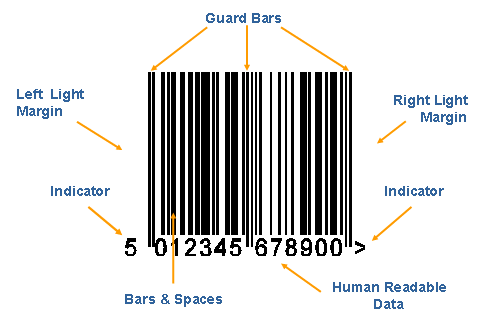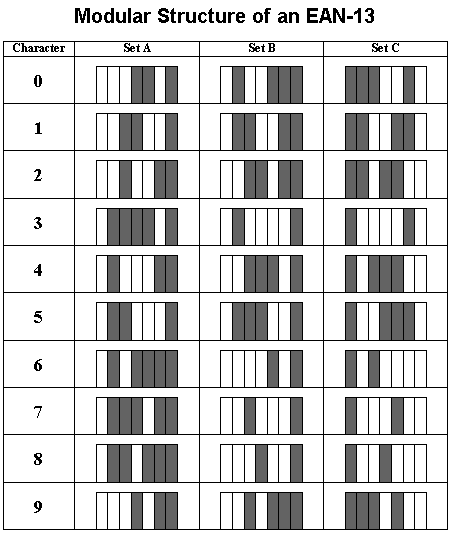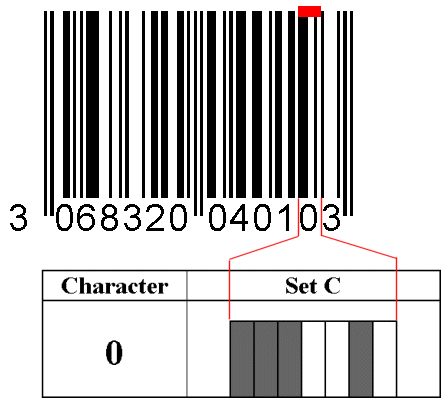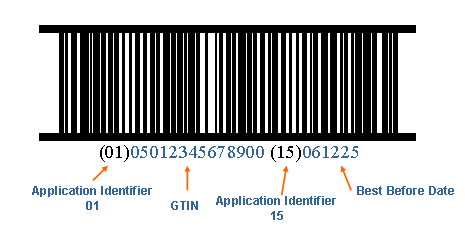Module 2
Focus on the industry standards and the GS1 symbologies
Go Back to
the Main Menu
Axicon are committed to designing and manufacturing
verifiers which meet all of the appropriate standards.
But just what are these standards ? In this module we attempt to cover the essential elements of the compliance issues.
First we will identify the standards we refer to and how they
interact together, then we will explain in more details how Axicon
complies with these various standards.
1. How the
various standards interact
These standards do not work in isolation from each other but rather fit together like a jigsaw
puzzle, as inter-relating elements, as described in the drawing below:

1-1:
The Symbology Specifications Standards
1-1-1 Introduction
Each “Symbology” is a machine readable typeface controlled by clear specifications as to how each human-readable character should be
encoded, along with the permitted tolerance limit, and the measurements which need to be taken to ensure that the
symbol is readable.
If we are going to choose to use a particular barcode symbology, then we
must print the code correctly if we want it to be scannable.
The tolerance limits are not ours to decide and failure to comply with the print quality requirements will degrade the scannability of the code.
The issues involved here are:
The most commonly referred to Symbology Specifications are
EN 797 Barcode – Symbology Specification - "EAN/UPC"
EN 798 Barcode – Symbology Specification - "Codabar"
EN 799 Barcode – Symbology Specification - "Code 128"
EN 800 Barcode – Symbology Specification - "Code 39"
EN 801 Barcode – Symbology Specification - "Interleaved 2 to 5 / ITF"
1-1-2 Focus on some GS1
symbologies
This chapter will be an introduction to
some of the GS1 most used symbols. The information is rather minimal.
The aim is to emphasize some characteristics of the barcodes
construction or data structure that will play a role in the quality
control of the symbols.
EAN-13
The EAN-13 barcode is one of the
EAN/UPC symbologies and it is arguably the most widely used throughout
the world to mark retail products that are scanned at points of sale.
The diagram below shows an image of an EAN-13 barcode. The human
readable data is written under the barcode i.e the machine readable
data.
On both sides of the barcode, the light
margins (also called Quiet Zones) are the areas left free of any
marking to guarantee that nothing is going to be in the way of the
reader when it scans the barcode so that there is no confusion as to
where the barcode starts and ends. The first digit in the human readable
and the indicator at its right can be used to give a
physical indication of the minimal width required for the light
margins.

The guard bars are used to
structure the barcode. They consist of a set of bar/space/bar at the
start and the end of the barcode and a sequence of
space/bar/space/bar/space right in the middle of the barcode. The rest
of the bars and spaces encode the digits of the code according
to a set of rules we will now explain in a simple
way.
Looking carefully at
examples of EAN-13 you will notice that it has four possible different
widths of bars and spaces. All the bars and spaces are in fact built
on the base of the smallest bar also called the X dimension or the
nominal bar such as the first bar at the start of the code. Each bar
in the code has either the same width, twice the width or three or
even four times the width of the nominal bar. This is also true for
the spaces. An EAN-13 barcode is therefore a sequence of bars and
spaces of different width (1 to 4). Two different EAN-13 barcodes will
have the same amount of bars and spaces but the width of these bars
and spaces will be different because they encode different numbers.
The table below gives the
modular structure of the EAN-13 encodation for each of the ten digits
from 0 to 9. There are three possibilities (sets A, B & C) for
each digit. The set C is always used in the right half of the barcode,
for the last 6 digits of the code, encoded at the right of the middle
guard bars. For the left part of the barcode, things are a little
different. As a matter of fact the first digit, 5 in the example
above, is not encoded by bars and spaces. The 6 digits from the second
digit to the 7th only are encoded, either in Set A or in Set B. The
lead digit is then deducted from the sequence of A or B used.

The Modular structure
table here above is a useful tool to understand how an EAN-13 barcode
is constructed.
In the diagram below, we
have zoomed on the digit 0 in Set C, it is
represented by a bar of 3 modules then a space of 2 modules then a bar
of 1 module and a space of 1 module. The structure B3/S2/B1/S1 that is
indicated in the table can be easily spotted in the barcode too, where
the last "0" of the code is encoded. Using the modular
structure table (and a magnifying glass!) you could easily read any barcode that
is printed well enough.

ITF-14
The ITF-14
barcode is used to mark outer cases handled in logistic operations
which do not get scanned at the till. This symbol has also got a
specific structure, with guard bars at the start and the end of the
barcode, left and right light margins. Here there are only two
different width of bars and spaces. The smallest bar (the X dimension)
is called the narrow bar. The wide bar is related to the narrow bar by
a ratio that is generally of 2.5, so the wide bar has 2.5 times the
width of the narrow bar. This is also true for the spaces. Very often
the ITF-14 barcode is framed by what is called the Bearer Box. This is
used to avoid short reading of the barcode and to even the pressure
over the barcode for some printing processes.

EAN/UCC-128
The EAN/UCC-128 symbol is used to mark
outer cases (it is mandatory when the product shelf life is less than
42 days) and also for pallet labels. As per the EAN-13, the structure
is modular, with 4 different width of bars and spaces, but here the
modular structure is completely different to the structure of the
EAN-13.
EAN/UCC-128 is in fact a subset of the
Code 128 symbology. It is identified by the use of a lead character
called the Function 1 character, encoded straight after the start
character. This symbol is of a variable length and the data is
organised by Application Identifiers (AIs). In the example below, both
AIs 01 and 15 are used. AI 01 encodes a 14 digit long code that
represents the Global Trade Item Number of the product and the AI 15
encode the best before date for this product, displayed by 6 digits on
the format YYMMDD (25 December 2006 in the example below). There is an
exhaustive list of AIs in the GS1 Genspec for all sorts of
applications. When one checks the quality of an EAN-128, it is not
just the print quality that is verified but also the conformity of the
data structure.

1-2:
The ISO/IEC 15416-1 Standard
ISO 15416-1 "barcode print quality test specification - part 1 linear symbols".
This standard specifies the method by witch we measure the quality of a printed linear
barcode. It applies to those symbologies for which a
reference decode algorithm has been defined and which are intended to
be read using linear scanning methods.
The
method for assessing the print quality of the barcode is based on
measuring the diffuse reflectivity of the barcode and its substrate
along a number of scan paths which shall traverse the full width of
the symbol, including both quiet zones. This is done according to a
given optical arrangement, measuring aperture and peak light
wavelength (See comments). A scan reflectance profile is extracted and
analysed to measure several parameters which are then graded. The
overall symbol grade is then calculated and reported using the form: Grade/Aperture/Wavelength.
e.g 4.0/06/660.
Comments:
1/
EN 1635 and ANSI X3.182 are the European and American equivalent
of ISO 15416-1 (the main difference with ANSI is the A-F grading as opposed to 4-0 in ISO and CEN)
2/
In chapter 5.1, Measurement requirement, the standard specifies that
the measurements shall be made with a single light wavelength and
measurement aperture of a diameter defined by the application standard
or if unavailable determined in accordance with chapter 5.2.1 and
5.2.2 of the ISO standard. This is a perfect example of how the
standards interact, here the ISO recognises that for specific
measurements parameters like the aperture or the light wavelength, the
application standards should overrule the ISO specifications.
1-3:
The ISO 15426-1 Standard
ISO 15426-1 " barcode verifier conformance specification - part 1 linear symbols"
This refers to the actual equipment used to perform the ISO 15416-1 method of verification.
This standard lists the mandatory functions that a conforming verifier must be capable
to perform.
It also specifies the tolerances which must be met when measuring Primary Reference Test Symbols
1-4:
The Application Standards These
standards
are specific to each industry and given application. The most common one being the
Genspec,
as in the GS1 General Specifications. This is the “Application Specification” which controls
all barcodes within the retail supply chain. It specifies
all factors such as: barcode symbology or mandatory
requirements for each application, barcode size for each application,
bar height, location and orientation of the code on the product, minimum
acceptable quality grade, wavelength of light and aperture size to be used to measure the
code...
Other Application Standards:
CFR 21 is an “Total Audit Traceability” requirement within the pharmaceutical industry.
Spec 2000 is for the aerospace industry
NDC 2001 is an EAN/UPC National Drug Code.
EN 1573: Transport industry
1-5/ How do these standards interact ?
What is important to understand is that these 4 families of standards all interact. Example : If
you verify an EAN-13 barcode applied on a product sold in a supermarket
you then have to comply to:
Genspec: because this is sold at a retailers point of sale. This is what will define the minimum C grade pass note, the verifier’s aperture (150 microns) and wavelength (670nm +/-10) the allowed magnification (80 to 200%), the light
margins (11X Left Margin, 7X right Margin), etc...
EN797: Because it is an EAN/UPC barcode. That is where the
reference decode algorithm is specified, the control character, the
structure...
ISO-15416 et ISO-15426 Because as specified in the Genspec, this is the method you are supposed to use to grade
the print quality level of the barcode.
2.
How to setup & use your Axicon verifier to comply with these standards
2-1:
Compliance to the symbology specifications
The reference decode algorithms specified in the symbology
specifications are used by the Axicon verifier for the relevant symbols, hence
the Axicon verifier software complies with the following symbology
specifications:
EN 797 Barcode – Symbology Specification - "EAN/UPC"
EN 798 Barcode – Symbology Specification - "Codabar"
EN 799 Barcode – Symbology Specification - "Code 128"
EN 800 Barcode – Symbology Specification - "Code 39"
EN 801 Barcode – Symbology Specification - "Interleaved 2 to 5 / ITF"
2-2:
Compliance to ISO 15416-1
Compliance to the ISO/IEC 15416-1 standard is achieved by using the
specified optical arrangement to analyse the diffused light
reflectivity and by calculating the relevant parameters from the
reflectance profile.
2-3:
Compliance to ISO 15426-1
Independent tests have been carried out and Axicon Series 6000, 6500
and 7000 have been certified to comply with the ISO 15426-1 standard.
To comply with this standard the verifier must perform a list of
function (established in chapter 6.3) and provide accurate results, with
certain tolerances, when scanning reference test cards.
2-4:
Compliance to the Application Standards
2-4-1 About the GS1 General Specifications (Genspec)
Most of today's users of barcode quality control equipment are
involved in the retail supply chain, where the Genspec application
standard, promoted by GS1, is the reference guide for all matters
relating to the barcoding best practice. This standard is also being
used more and more outside the retail supply chain, particularly for
healthcare applications. For that reason we have integrated into
our software the possibility to automatically check some of the Genspec
requirements that can be measured by a barcode verifier, like the
magnification. We have also taken into account within the settings those
parameters where the application standard over-rules the ISO 15416-1
standard, like the measuring aperture.
In the General tab of
the Setup window, you have the option to tick the Apply Genspec box.
By doing so, the minimum pass grade will be allocated as per the
Genspec rules. The table below summarises the Genspec requirements. For
more comprehensive information, please report to the Specification Tables, in
the Chapter 5.4 of the latest issue of the Genspec. Click
here for a link to Genspec Chapter 5.4
Summary table for the
main GS1 linear symbologies:
|
Symbology
|
Scanned
at/in:
|
Example
|
X dimension mm
|
Magnification
|
Minimum pass grade/Aperture
|
|
EAN/UPC
|
Point of
sales only
|
Bottle of water
|
[0.264 -
0.66]
|
[80% -
200%]*
|
1.5/10
|
|
EAN/UPC
|
Warehouse or POS
|
Pack of 6 bottles
|
[0.495 -
0.66]
|
[150% -
200%]
|
1.5/10
|
|
EAN-128
|
Warehouse
|
Tray of
fresh fruits
|
[0.495 - 1.016]
|
[48.7% - 100%]
|
1.5/10
|
|
EAN-128
|
Logistic operations
|
Pallet
label
|
[0.495 - 0.940]
|
[48.7% - 92.5%]
|
1.5/10
|
|
ITF-14
|
Warehouse
|
Outer case
|
[0.495 - 0.635[
[0.635 - 1.016]
|
[48.7% - 62.5%[
[62.5% - 100%]
|
1.5/10
0.5/20
|
* For an EAN/UPC barcode printed with an
on demand process ( e.g.. thermal transfer), the allowance goes down to
75%
Parameters
checked by the verifier: (displayed in the Summary Window):
-
ISO grade.
If the average grade is lower than the minimum pass grade for this
symbology (as per the table above) then a red flag will be
displayed If the average grade is above the minimum pass grade by
less than 0.5, a yellow flag will be displayed. Please note that
for EAN/UPC, ITF-14 and EAN-128 barcodes, the verification of the
light margins and the check character are part of the ISO grading
(Decode parameter).
-
Wide to Narrow Ratio (where
applicable): A red flag will be displayed if the ratio is outside
the specifications. For an ITF-14 barcode, the ratio is
tolerated between 2.25 and 3.
-
Barcode X
dimension (Magnification): If the X dimension is outside the Genspec
tolerance value shown in the table above, a red signal will be displayed. A
yellow signal will be displayed in the case of an EAN/UPC barcode
with a magnification between 75% and 80%.
Parameters
not checked by the verifier:
-
Bar height. The
specification are as follows: For a retail unit scanned at point
of sales, the minimum acceptable height is 20.73 mm (Including
human readable) and for a barcode read in warehouse/logistics
operation, 32 mm (Bar height only this time). Even though some
packagings do not leave enough room for such heights and it can be
agreed between trading partners to truncate the barcode further,
it should be noted that the readability of a barcode will be
highly affected by a too excessive truncation.
Comments:
1/ For anyone involved with printing or handling barcodes, compliance
to the Genspec is a process which takes several steps, some of which
can be carried out by the Axicon verifier. The table below is a
summary of these steps involved in checking barcode compliance to the
Genspec:
|
Level
|
Check
|
Done
by the verifier
|
Iso
Grading
|
|
1
|
Is the code correct
(right code on the right product)
Right Symbology used ?
Does the barcode match the human readable code?
Location / Orientation
Bar Height / Truncation
|
NO
|
NO
|
|
2
|
Size (Magnification)
/ Ratio
Bar Gain (no tolerance value specified in the Genspec)*
Data Conformity
|
YES
|
NO
|
|
3
|
Print Quality ISO Grade
- Decode
- Rmin
- Symbol Contrast
- Minimum Edge Contrast
- Modulation
- Defects
- Decodability
|
YES
|
YES
|
* The Average Bar Gain
check does not relate to the Genspec and does not get an ISO grade.
It's tolerance values are set in the Traditional Verification method.
It's mentioned here because it is relevant to the print quality
verification.
2/
The idea for presenting the table above is to show how compliance to
the GS1 General Specifications is not limited to obtaining a pass
ISO/ANSI grade. A barcode could fail the Genspec for size or bar
height but be well printed and obtain a satisfactory grade.
2-4-2 Compliance to
CFR-21 Part-11
This is so important essentially because many companies either in the pharmaceutical industry or as suppliers to pharmaceutical companies will insist on CFR21 Part 11 compliance before
allowing them to be an approved supplier.
Regarding CFR21 Part 11 the issues are generally as follows:-
a) Much of the requirement is on the features of the product – and here our software can be set-up in such a way as to ensure compliance.
This includes such things as ensuring that the equipment cannot be used after a pre-determined calibration period, ensuring that only valid calibration materials be used, ensuring that all scans made are timed and dated, that they are sequentially numbered, that full data (scn file) is recorded on calibration processes, that the name of the person taking the scan can be recorded (user name.avp) etc...
b) The second part of the process concerns product compliance with standards.
c) The final part relates to the design and manufacture of the product and manufacturing process control.
For a more detailed
information on how to setup the software to comply with CFR-21 Part
11, please contact Axicon.
DISCLAIMER
This document is intended as a recommendation of work practices sponsored by Axicon Auto ID Ltd. Whilst this document is believed to contain correct information, neither Axicon Auto ID Ltd nor any of it’s associated companies, nor any of it’s employees, make any warranty, express or implied, or assume any legal responsibility for the accuracy, completeness or usefulness of such information that its use would not infringe privately owned rights. Reference herein to any specific commercial product, process, or service by its trade name, trademark, manufacturer or otherwise, does not necessarily constitute nor imply Axicon Auto ID Ltd endorsement nor recommendation. The views and opinions of authors expressed herein do not necessarily state or reflect those of Axicon Auto ID Ltd.
| 




